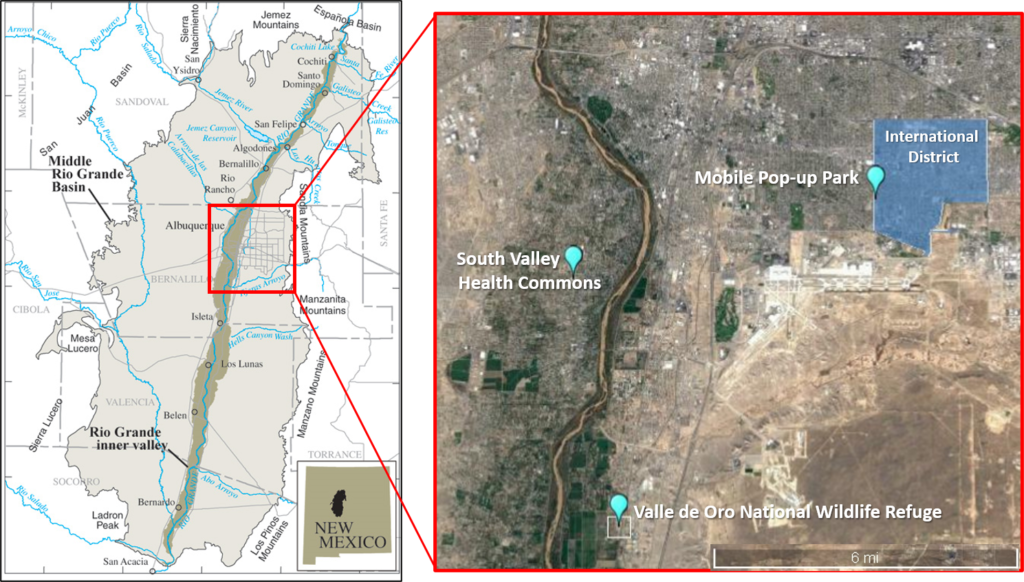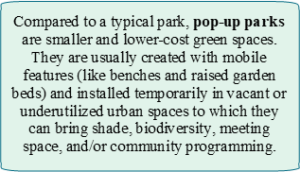The Middle Rio Grande faces unique urban challenges due to regional drought and competing water uses. To address these issues, the area was designated as an Urban Waters Federal Partnership location in 2013. From large redevelopment projects to smaller, unique projects—like the Mobile Pop-Up Park —the Partnership has worked together with the community to become a partnership of ‘yes’. As Mandy Griego, former Partnership co-lead, puts it: “We are stronger together.”

The Middle Rio Grande River flows through the City of Albuquerque. This region hosts the Middle Rio Grande Urban Waters Federal Partnership, in which groups collaborate to enhance environmental protections and public health in vulnerable communities. Map on left from the USGS.
Middle Rio Grande Watershed
With headwaters originating in the mountains of southern Colorado and flowing to the Gulf of Mexico, the Rio Grande is the fifth longest river in the United States and the largest river in New Mexico. The Middle Rio Grande comprises a 161-mile section of the river through New Mexico, flowing from the Cochiti Dam through Bernalillo County and the City of Albuquerque to San Marcial. In a state of about two million people, Bernalillo County alone is home to close to 700,000 of the population.
The city of Albuquerque is nestled between two Native American Tribes—the Sandia Pueblo to the north and the Isleta Pueblo to the south—whose members continue to use the river as prior generations have done. The arid climate, a growing population and competing water uses all contribute to frequent drought conditions that affect natural and human communities along the river. Especially vulnerable are the underserved communities in the region where residents experience high levels of unemployment, poverty, and lack of green spaces.
Middle Rio Grande/Albuquerque Urban Waters Federal Partnership
To reconnect low-income residents to their waterway and to preserve the cultural and historical importance of the Middle Rio Grande Watershed, the US Environmental Protection Agency (EPA) designated the area as an Urban Waters Federal Partnership location in 2013. Starting in 2014, the U.S. Department of Housing and Urban Development became the lead federal agency for the Partnership, and a representative from the The Nature Conservancy (TNC) became an Urban Waters Ambassador.
The Partnership was launched with several original projects and objectives that included creating the Valle de Oro National Wildlife Refuge in cooperation with the U.S. Fish and Wildlife Service, working with Bernalillo County on the Bridge Boulevard Redevelopment Plan, and uplifting members of the community as stewards of their watershed. Since its inception, the Partnership has achieved noteworthy accomplishments toward each of its original goals. Projects like the South Valley Health Commons have helped the Partnership expand beyond its original goals to include new agencies and communities. Together, it has become a “partnership of yes!” working with federal, local, and community-led organizations to revitalize the environment while promoting economic and social benefits.
A Recent Highlight: The Mobile Pop-Up Park
 While the Rio Grande River is the lifeblood to the largest cottonwood gallery riparian forest in the southwestern United States—locally called the Bosque—the City of Albuquerque has a meager 10% canopy cover. Densely populated and culturally diverse areas like Albuquerque’s International District (ID) have even less. With fewer public parks than other parts of the city, the ID has an estimated three percent of tree cover and as a result experiences harsh impacts from urban heat island effects. With funding from the National Fish and Wildlife Foundation’s (NFWF) Resilient Communities Program, TNC set out to change that.
While the Rio Grande River is the lifeblood to the largest cottonwood gallery riparian forest in the southwestern United States—locally called the Bosque—the City of Albuquerque has a meager 10% canopy cover. Densely populated and culturally diverse areas like Albuquerque’s International District (ID) have even less. With fewer public parks than other parts of the city, the ID has an estimated three percent of tree cover and as a result experiences harsh impacts from urban heat island effects. With funding from the National Fish and Wildlife Foundation’s (NFWF) Resilient Communities Program, TNC set out to change that.
Working with Artful Life, the Rocky Mountain Youth Corps (RMYC), and several community groups—including the ID Healthy Communities Coalition, the South San Pedro Neighborhood Association and the Elder Homestead Neighborhood Association—the groups designed and created a mobile “pop-up” park on a vacant plot of land within the ID. From January to May of 2019, Artful Life artists worked with neighborhood groups to co-design the park; the community vision for the park included lots of art. Following the design, RMYC employed youth to work with TNC to build mobile benches and containers set on wheels. The final installation also included three 4-sided murals around rain barrels and a large metal and plexi-glass sculpture called “Iris,” which casts colorful geometric shadows on the ground.

The community plants, paints and congregates at the Mobile Pop-up Park, one of the few green spaces within the densely populated International District. Plants and green space help to combat the heat island effect prominent in this area. Images: Roberto Rosales
 The park’s Community Build Day was August 3, 2019, and at least 50 community members volunteered to install the park that officially opened on August 6, 2019. Through the remainder of the year, volunteers from the community helped to maintain the space. Though the pop-up park was a temporary feature in the neighborhood, it brought joy to the neighborhood and partners by transforming a vacant lot into a green space. The project also received a lot of attention.
The park’s Community Build Day was August 3, 2019, and at least 50 community members volunteered to install the park that officially opened on August 6, 2019. Through the remainder of the year, volunteers from the community helped to maintain the space. Though the pop-up park was a temporary feature in the neighborhood, it brought joy to the neighborhood and partners by transforming a vacant lot into a green space. The project also received a lot of attention.
Local News Coverage of the Mobile Pop-Up Park:
- New Mexico In Focus, a Production of NMPBS: “Pop-up Park” Blooms in ABQ’s International District
- The Albuquerque Journal: Pop-Up Park is Cool
- KRQE: Teens build benches, shade structures for ‘Pop Up Park’
Once the park is dismantled in 2020, pieces of it will be distributed throughout the community to different organizations. While finding new locations for the entire mobile park proved to be a challenge, project leaders learned valuable lessons and made lasting connections throughout the development of the project, and confirmed that:
- the community is invested in designing, building and maintaining green spaces for its residents; and,
- mobile structures can be built and installed in a fun and efficient manner that provides employment skills to youth and brings multiple other benefits to the community.
Through a related project, TNC’s Urban Conservation Program continues to support green spaces in the South Valley by planting trees throughout the region—another initiative funded in 2018 by a NFWF Resilient Communities grant.

The Nature Conservancy’s Urban Conservation Program engages the community in planting trees throughout the City of Albuquerque. Images: Roberto Rosales
The Middle Rio Grande: A Unique Federal Partnership Location
The Middle Rio Grande is a unique location within the 19 designated Federal Partnerships. With its arid climate and diverse cultural setting, the challenges that the waterway faces in the urban sections of the river are different than those in more temperate climates. To combat these challenges, members of the Middle Rio Grande Federal Partnership are working to enhance natural habitats and promote water conservation. Through projects large and small—like the Mobile Pop-Up Park—partners are working to elevate community ideals for the common good and overall public health.
Resources and Further Reading
- The Nature Conservancy: Improving Quality of Life by Bringing Nature into the City
- The Nature Conservancy: Urban Conservation in New Mexico
- USGS publication: Chapter 4: The hydrologic system of the Middle Rio Grande Basin
For more information pop-up parks and their benefits, see:
- Next City: Pop-Up Parks Lead to More Biodiversity in Cities, Study Finds
- The Commons: The Rise of Pop-Up Parks
- Ground Play San Francisco: Parklet-O-Matic: A step-by-step process of implementing a parklet in San Francisco and A Look at the Human Impact of Parklets
- National Association of City Transportation Officials: Urban Street Design Guide: Parklets


